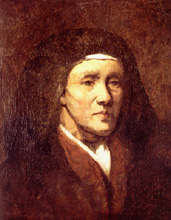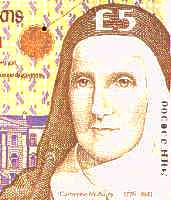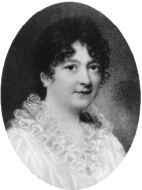
Nano Nagle
By kind permission of the Presentation Sisters
Five of these had been established by 1866:
The Presentation Sisters ( l775) by Nano Nagle
The Brigidines (1807) by Bishop Delany of Kildare and Leighlin
The Religious Sisters of Charity (1815) by Mother Mary Aikenhead
The Sisters of Mercy (1827) by Mother Catherine McAuley
The Holy Faith Order (1866) by Mother Margaret Aylward.
The Mercy Sisters became the largest religious community of women dealing with girls' education in nineteenth-century Ireland. There were a number of reasons for this. The Mercy Sisters were uncloistered and the visitation of the sick and poor was part of their work. This meant that they could go into the homes of the poor and persuade parents to send their children to school.
 Nano Nagle By kind permission of the Presentation Sisters |
The Presentation Sisters were not so lucky in this regard. They could no longer work outside their convents after they became strictly enclosed in 1805 and this helps explain why their schools never became so numerous as those of the Mercy Sisters. The rules of the Presentation Sisters stating that no school fees should be charged, helps explain why most of their schools remained primary schools during the nineteenth century and why its entry into second level education was of a much more limited nature than that of the Mercy Sisters. |
Nano Nagle had died in 1784 and it was Catherine McAuley, foundress of the Mercy nuns, who made the greatest impact on the education of girls in nineteenth-century Ireland.
Catherine McAuley (1778-1841) was an heiress, with a fortune of £25,000 which she had used to build a house in Baggot Street, Dublin in 1827. Here the children of the poor were educated, orphans housed and young women trained for employment. She believed that it was women who would regenerate society through their religious influence and was prepared to make use of any system of education which would bring about this end.Catherine was convinced that:
| ... no work of charity can be more productive of good to society or more conducive to the happiness of the poor than the careful instruction of women, since, whatever be the station they are destined to fill, their example and advice will always have great influence. S.M.O'Donoghue, Mother M. Vincent Whitty, Melbourne, 1972, p. 13. |
 Catherine McAuley was commemorated on an Irish banknote. |
Her school in Baggot Street was already well-established by 1831 with over 200 pupils to cater for. She had decided to introduce a modified version of the Lancasterian monitorial system to her poor schools in Dublin. The school day began with a twenty-minute religion class followed by the secular subjects: Reading, Writing, Arithmetic, Spelling, Grammar, Home Crafts and Deportment. Catherine McAuley affiliated her schools with the National Board in 1839. Others quickly followed suit and the number of convent schools linked to the Board grew from 133 in 1868 to over 300 in 1900. |
 Mary Aikenhead Foundress of the Religious Sisters of Charity |
The Catholic bishops banned Catholics from attending mixed denominational Model Schools or Training Colleges run by the National Board in 1863 and this enhanced the growing role of the convent schools in providing monitors and teachers in many girls' schools in Ireland. |
| Congregation | Founded by | Year |
| Presentation Sisters | 1807 | |
| Mother Mary Aikenhead | ||
| Sisters of Mercy | ||
| 1866 |